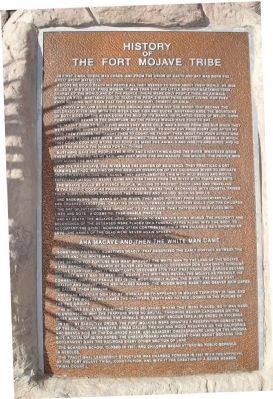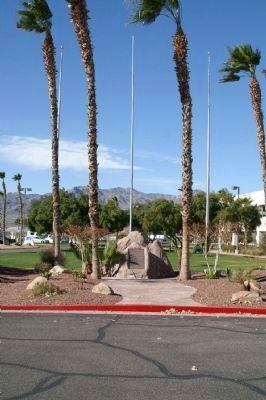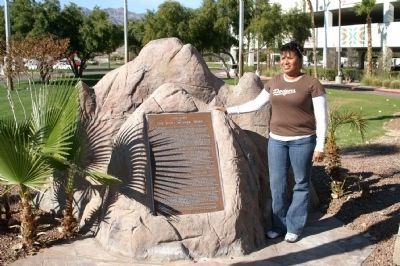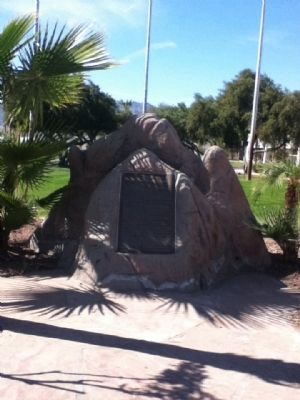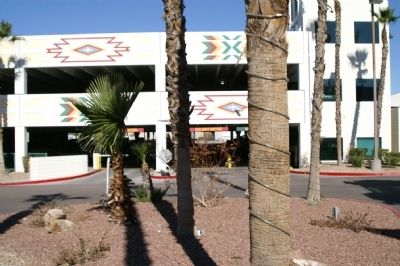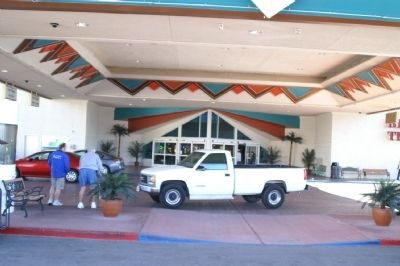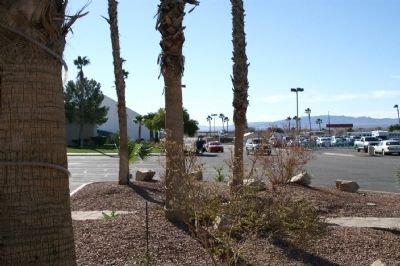Near Laughlin in Clark County, Nevada — The American Mountains (Southwest)
History of the Fort Mojave Tribe
In first times, there was chaos, and from the union of earth and sky was born the Great Spirit Matavilya.
Before he could teach his people all they needed to know about their world, he was killed by his sister, Frog Woman. It was then that his little brother Mastamho took charge of the world of the people. There were only people then, no animals, birds or fish. Mastamho had to teach the people everything about living, for they knew nothing, not even that they were hungry, thirsty or cold.
He drove a willow stick into the ground and drew out the water that became the Colorado River, and with the river came fish and ducks. Mastamho made the mountains on both sides of the river using the mud of its banks. He planted seeds of melon, corn, pumpkin and beans in the overflow, so the people would have food to eat.
He taught them to build fire when they were cold, and a shade from the sun when they were hot. He showed them how to count. He taught them about the four directions, about the food they grew, and he showed them how to make pottery vessels in which they could cook and store the food. He made the animals and insects and birds, and he gave the people the names for all things.
Mastamho gave the people the river and everything along the river. Whatever grew there was theirs, as he said, and they were the Aha Macave, the Mojave, the people who live along the water.
For the Aha Macave, the river was the center of existence. They practiced a dry farming method, relying on the regular overflow of the Colorado River to irrigate crops planted along the banks. They supplemented this with wild seeds and roots, especially mesquite beans, game and fish taken from the river with traps and nets.>br>
The Mojave could be a fierce people, willing to protect their land and traveling to the Pacific Coast as proficient traders, where they exchanged with coastal tribes their surplus crops for goods they desired and valued, such as shells.
And back along the banks of the river, they made pottery from sedimentary clay and crushed sandstone, creating cooking utensils and pottery dolls for the children.
The art of tatooing was important to the Mojave. They tattooed their faces with lines and dots - a cosmetic, fashionable practice.
And at death, the Mojaves used cremation to enter the spirit world. The property and belongings of the deceased were placed on a funeral pyres along with the body, to accompany the spirit. Mourners often contributed their own valuable as a showing of love. The names of the dead were never again spoken.
The search for fortune was what brought the white man to the land of the Mojave. A 1604 expedition in search of silver led New Mexico Governor Don Juan Onate through Mojave territory, but it wasn't until December 1775 that Fray Francisco Garces became the first white man to meet the Mojave. His writings reveal the Mojave as friendly. He comments that "The female sex is the most comely along the river, the males very healthy and robust." The men walked naked, the women wore rabbit and beaver skin capes. He called them Jamajab.
American mountain men led by Jedediah Smith appeared in Mojave territory in 1826, and though the Mojave welcomed the trappers, death and hatred loomed in the future of the two groups.
The Mojave believed all living things belonged where they were placed, so it was hard to understand why the trappers were so brutal, throwing beaver carcasses on the river bank after skinning the animals. Subsequent encounters also ended in violence.
In 1911, by Executive Order, the Fort Mojaves were granted a reservation consisting of the old military reserve, areas called the Hay and Wood Reserves on the California and Nevada side of the Colorado River, and adjacent checkerboard land on the Arizona side, a total of 32,000 acres. The checkerboard arrangement came
about because the government gave the railroad every other section of land.
The Boarding School closed in 1931, and children began attending public school in Needles.
The traditional leadership structure was changed forever in 1957 with the approval of the Fort Mojave Tribal Constitution, and with it the creation of a seven member Tribal Council.
Topics. This historical marker is listed in these topic lists: Exploration • Native Americans. A significant historical date for this entry is December 28, 1775.
Location. 35° 0.945′ N, 114° 38.552′ W. Marker is near Laughlin, Nevada, in Clark County. Marker is on Avi Casino Drive, 1.8 miles west of Needles Highway, on the left when traveling north. Touch for map. Marker is at or near this postal address: 1000 Aha Macav Parkway, Laughlin NV 89028, United States of America. Touch for directions.
Other nearby markers. At least 8 other markers are within 7 miles of this marker, measured as the crow flies. Von Schmidt State Boundary Monument (approx. 1.1 miles away in California); a different marker also named Von Schmidt State Boundary Monument (approx. 1.1 miles away in California); Oatman (approx. 4.2 miles away in Arizona); Arizona Veterans Memorial (approx. 5.4 miles away in Arizona); In Memory of All Vietnam Veterans (approx. 5.4 miles away in Arizona); Arizona Medal of Honor (approx. 5.4 miles away in Arizona); 9/11 Arizona Heroes Memorial (approx. 5.4 miles away in Arizona); The Garcés Expedition (approx. 6.3 miles away).
More about this marker. Immediately west of the Avi Casino entrance.
Also see . . . Fort Mojave Indians - People Who Live Along the Water. A detailed history written by the Fort Mojave Tribe. (Submitted on February 1, 2011.)
Credits. This page was last revised on December 4, 2020. It was originally submitted on February 1, 2011. This page has been viewed 2,179 times since then and 67 times this year. Last updated on February 15, 2011. Photos: 1, 2, 3. submitted on February 1, 2011. 4. submitted on February 24, 2015, by Bill Kirchner of Tucson, Arizona. 5, 6, 7. submitted on February 1, 2011. • Syd Whittle was the editor who published this page.
